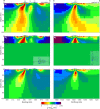Trans-crustal structural control of CO2-rich extensional magmatic systems revealed at Mount Erebus Antarctica
- PMID: 35637190
- PMCID: PMC9151792
- DOI: 10.1038/s41467-022-30627-7
Trans-crustal structural control of CO2-rich extensional magmatic systems revealed at Mount Erebus Antarctica
Erratum in
-
Author Correction: Trans-crustal structural control of CO2-rich extensional magmatic systems revealed at Mount Erebus Antarctica.Nat Commun. 2022 Jul 13;13(1):4062. doi: 10.1038/s41467-022-31694-6. Nat Commun. 2022. PMID: 35831312 Free PMC article. No abstract available.
Abstract
Erebus volcano, Antarctica, with its persistent phonolite lava lake, is a classic example of an evolved, CO2-rich rift volcano. Seismic studies provide limited images of the magmatic system. Here we show using magnetotelluric data that a steep, melt-related conduit of low electrical resistivity originating in the upper mantle undergoes pronounced lateral re-orientation in the deep crust before reaching shallower magmatic storage and the summit lava lake. The lateral turn represents a structural fault-valve controlling episodic flow of magma and CO2 vapour, which replenish and heat the high level phonolite differentiation zone. This magmatic valve lies within an inferred, east-west structural trend forming part of an accommodation zone across the southern termination of the Terror Rift, providing a dilatant magma pathway. Unlike H2O-rich subduction arc volcanoes, CO2-dominated Erebus geophysically shows continuous magmatic structure to shallow crustal depths of < 1 km, as the melt does not experience decompression-related volatile supersaturation and viscous stalling.
© 2022. The Author(s).
Conflict of interest statement
The authors declare no competing interests.
Figures





References
-
- DasGupta R, Hirschmann MM, Smith ND. Partial melting experiments of peridotite+CO2 at 3 GPa and genesis of alkalic ocean island basalts. J. Petrol. 2007;48:2093–2124.
-
- Foley SF, Fischer TP. An essential role for continental rifts and lithosphere in the deep carbon cycle. Nat. Geosci. 2017;10:897–902.
-
- Kyle PR, Moore JA, Thirlwall MF. Petrologic evolution of anorthoclase phonolite lavas at Mount Erebus, Ross Island, Antarctica. J. Petrol. 1992;33:849–875.
-
- Kelly PJ, Kyle PR, Dunbar NW, Sims KWW. Geochemistry and mineralogy of the phonolite lava lake, Erebus, Antarctica:1972-2004 and comparison with older lavas. J. Volc. Geoth. Res. 2008;177:589–605.
-
- Self, S., Gertisser, R., Thordarson, T., Rampino, M. R., & Wolff, J. A. Magma volume, volatile emissions, and stratospheric aerosols from the 1815 eruption of Tambora. Geophys. Res. Lett. 31, 10.1029/2004GL020925 (2004).
Grants and funding
LinkOut - more resources
Full Text Sources

